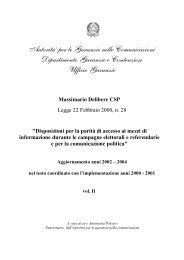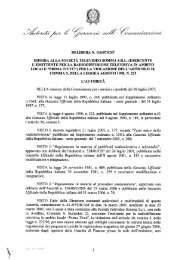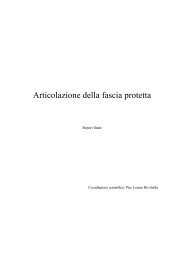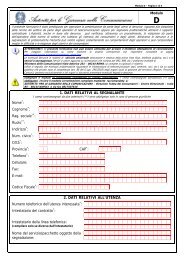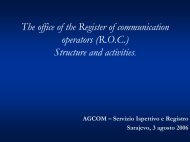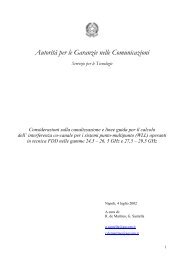Communications Regulatory Authority
Communications Regulatory Authority
Communications Regulatory Authority
Create successful ePaper yourself
Turn your PDF publications into a flip-book with our unique Google optimized e-Paper software.
operator. Moreover, as previously mentioned, the shared access encouraged the offer of<br />
VoIP solutions in the Italian market. On ADSL connections activated by providers in<br />
shared access mode the alternative operator can activate VoIP lines offering a voice<br />
quality which is by far better than that of VoIP lines activated on wholesale connections<br />
acquired from the incumbent.<br />
The transition to a competition model based on the use of infrastructures<br />
alternative to those of the incumbent operator (not only shared access but above all full<br />
unbundling) is - as previously explained - a signal of the maturity of the Italian market.<br />
As a matter of fact this is, inter alia, a prerequisite for the development of innovative<br />
services, such as IP TV. The opportunity allowed by unbundling to control the<br />
connection enabling the use of IP TV services is considered by TLC operators as key<br />
element for the success of their offers.<br />
In this connection, it is to be pointed out that, at the end of 2005, Telecom Italia<br />
launched its offer of television on Internet protocol which, in addition to a section of<br />
free contents (included in the basic subscription), includes for-pay contents available in<br />
pay-tv mode (Sky Italia packages) and in pay-per-view and video on demand modes.<br />
The service joins the one offered by Fastweb, the first Italian triple play operator, and,<br />
by the end of 2006, it should be followed by the launch of similar services by Wind and<br />
Tiscali.<br />
Significant changes occurred for broadband connectivity via wi-fi (Wireless<br />
Fidelity) and wi-max (Worldwide Interoperability for Microwave Access) technology.<br />
At the beginning of October 2005, the Ministerial Decree of May 2003 on wi-fi was<br />
changed considerably. The main change refers to the removal of the operativeness limit<br />
of wi-fi in places open to public and in public-attended confined areas. This change<br />
enables authorized operators to provide wi-fi services throughout Italy, by allowing the<br />
interconnection of access points of their own network without any geographic<br />
restriction. One of the most interesting applications of this technology consists in the<br />
possibility to provide broadband connectivity in areas not reached by ADSL. In this<br />
connection, it is to be pointed out that Italian cities announced many contracts for the<br />
carrying out of broadband infrastructures by means of wi-fi technology in order to reach<br />
the most inaccessible towns.<br />
Furthermore, in July 2005, tests on wi-max technology were stared on<br />
frequencies made available by the Ministry of Defence. This technology has a<br />
transmission standard enabling connectivity at high speed on wireless networks having<br />
a theoretical maximum capacity of 50 km in rural areas and real speed between 8 and 20<br />
Mbps. Tests were supposed to be completed at the end of the year, however, due to a<br />
respite, the deadline is now set at the end of June 2006. Once tests have been completed,<br />
a public consultation among operators will take place in order to consider the<br />
willingness to invest in this technology. Upon completion of the consultation the<br />
procedure for the allocation of licences will be defined. This technology allows a<br />
number of applications; wi-max (in the standard wi-max 802.16-2004 version) can be<br />
used as: a) broadband wireless access in fixed or nomadic mode (i.e. enabling a limited<br />
68




